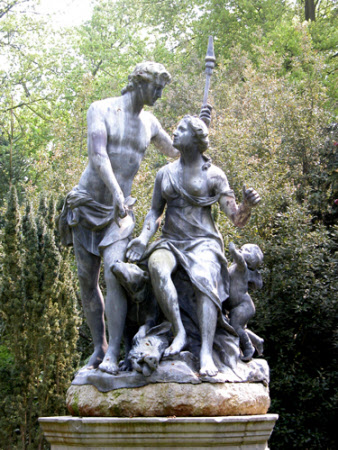‘The Olympian Courtship’, Meleager offering Atalanta the head of the Calydonian Boar
attributed to John Cheere (London 1709 – London 1787)
Category
Art / Sculpture
Date
circa 1750 - 1760
Materials
Lead
Measurements
2050 x 1040 x 800 mm
Place of origin
London
Order this imageCollection
Anglesey Abbey, Cambridgeshire
NT 515135
Summary
Lead on Portland stone base, ‘The Olympian Courtship’, attributed to John Cheere (London 1709 - London 1797), after Francesco Fanelli (Florence 1590 - Paris 1653), mid 18th century. A lead group depicting Meleager offering Atalanta the head of the Calydonian Boar. The standing Meleager, with spear in his proper left hand, points towards the severed head of the Calydonian Boar which he has slain, and looks towards the seated Atalanta. A hound looks up from between their legs, whilst a cupid tugs at her tunic from behind her. Mounted on a panelled Portland stone base. Incised on side of rock under Cupid’s left foot with apocryphal signature and date, punched with holes (now partly defaced by repair) 'J. Chee[re] 168[?]0 or 1690'. Removed from Copped Hall, Essex, c. 1950.
Full description
This cast of the ‘Olympian Courtship’ once stood in the gardens of Copped Hall, a Georgian, formerly Elizabethan, country house near Epping which was gutted by fire in 1917 and finally sold after decades of neglect in 1950 (reproduced Country Life, 5 November 1910, p. 653). Much of the statuary and garden furniture was removed to estates across the country including Anglesey Abbey, where a pair of late 19th century obelisks and balustrading by Charles Eamer Kempe (NT 516657) and casts of Diana and Apollo by John Cheere (NT 515159–515160) are also relics of the Essex estate. The present cast may originally have been installed c. 1745-58, when John Conyers (1717-75) rebuilt Copped Hall as a fashionable mid-Georgian mansion with landscaped gardens, or much later in the 1890s, when Ernest James Wythes, then the owner, commissioned Kempe to create an elaborate Italianate garden which included sculptural elements now at Anglesey Abbey. Attribution of the cast has been somewhat confused by the inscription on its base currently catalogued as ‘John Chee[re] 16[...]’, the date defaced by repairs done in the 1990s. Lanning Roper, writing in 1964, records the group as ‘signed by John Cheere and dated 1720’ (Roper 1964, p. 80) and also refers to the statue by its historic title, Diana and Actaeon (though he writes ‘it more probably represents Venus and Adonis’). As Cheere established his workshop on Nost premises in 1737, purchasing stock and moulds from Andrew Carpenter (d. 1737) and John Nost II (d. 1729) which he regularly used and adapted, the inscription was likely added later to increase the cast’s market value. No casts of the Olympian Courtship model predating Cheere appear to survive. Indeed, the earliest recorded cast of the model was part of the monumental commission Cheere received from Prince Pedro of Portugal (1717-86) for 138 pieces of lead sculpture for the gardens of the Palace of Queluz (1755-56; see Neto and Grillo 2006). The group is recorded in the price list sent by Cheere to Portugal as ‘Une groupe de Meleager & d’ atalante de 5 pieds 6 pouces avec a cupidon, un chien & une tête de Sanglier’, priced at £40.0.0 (transcribed Neto and Grillo 2006, p. 16). Cheere adapted the group in c. 1756 to make a cast of Diana and Endymion for Wrest Park, adding to Atalanta Diana’s crescent moon crown and quiver and removing Cupid. Cheere’s figures and composition originate from a group of small bronzes depicting Venus and Adonis by the Genovese sculptor Francesco Fanelli (1577-c.1641) which are now in the V&A. By 1635 Fanelli was working at the English court and the V&A owns several bronzes by ‘ffrancisco the one-eyed Italian’ listed in the 1639 inventory of Whitehall Palace. Casts A.118-1910 and A.58-1956 showing Venus and Adonis with a slain boar and dogs and cast A.96-1956 showing Venus and Adonis with Cupid, dogs and a slain boar are closest to Cheere’s model and were cast with slight variations from the same mould, in around 1640. Alice Rylance-Watson 2019
Provenance
Originally installed at Copped Hall, Essex, seat of the Conyers family 1739-1869, seat of George Wythes from 1869 and Ernest James Wythes from 1887 to1917, removed 1950; sold as 'Large life size lead group of "Diana and Actaeon" on a Portland stone pedestal' by Bert Crowther of Syon Lodge to Urban Huttleston Rogers Broughton, 1st Lord Fairhaven (1896-1966), 16 December 1950, with Diana and Apollo by Cheere (NT 515159 and 515160) and Silenus with the infant Bacchus (NT 515152), for £1600; bequeathed to the National Trust by Lord Fairhaven in 1966 with the house and the rest of the contents.
Credit line
Anglesey Abbey, The Fairhaven Collection (The National Trust)
Marks and inscriptions
Base, side of rock under Cupid's left foot: J. Chee[re] 16[..] (punched with holes)
Makers and roles
attributed to John Cheere (London 1709 – London 1787), sculptor after Francesco Fanelli (b.1577), sculptor previously catalogued as attributed to John Nost I (Mechelen c.1655 - London 1710) or Andrew Carpenter (c.1677 - London 1737) , sculptor
References
Roper 1964: Lanning Roper, The Gardens of Anglesey Abbey, Cambridgeshire. The Home of Lord Fairhaven, London 1964, p. 80. Neto and Grilo 2006: Maria João Neto and Fernando Grilo, 'John Cheere's lead garden statues workshop and the important commissions of Prince Pedro of Portugal in 1755-56', Sculpture Journal, vol. 15.1 (2006), pp. 5-18. Fulton 2003: Moira Fulton, ‘John Cheere, the eminent statuary, his workshop and practice, 1737-1787, Sculpture Journal, X, 2003, pp. 21-39. 'Country Homes, Gardens, Old & New, Copped Hall. - I. Essex, The Seat of Mr. E. J. Wythes', Country Life, October 29, 1910, pp. 610-7. 'Country Homes, Gardens, Old & New, Copped Hall. - II. Essex, The Seat of Mr. E. J. Wythes', Country Life, November 5, 1910, pp. 646-53.

